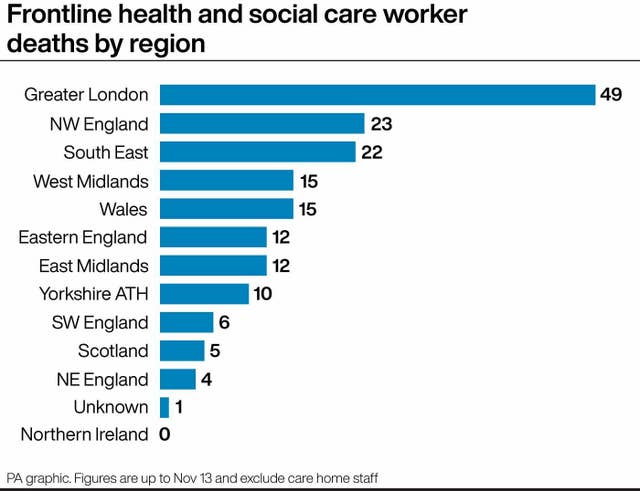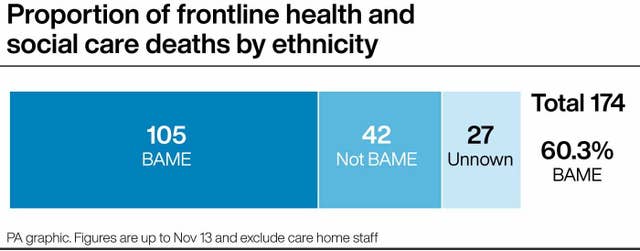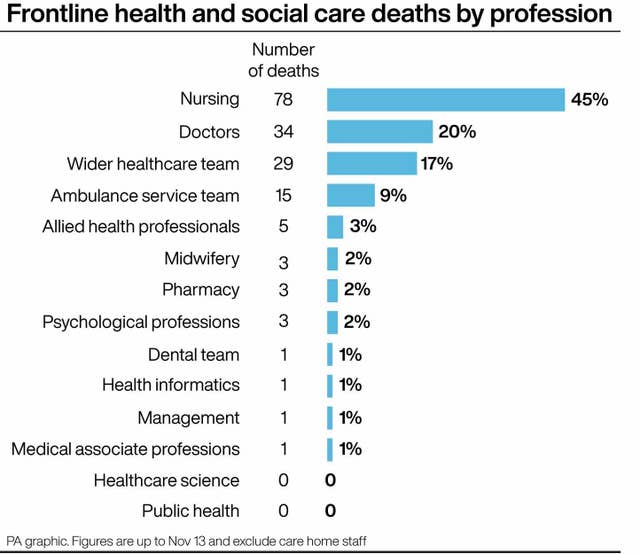At least 200 frontline health and care workers have now been named following their deaths after contracting coronavirus.
Through tributes from loved ones and confirmation through sources, including local NHS trusts and other authorities, the PA news agency has confirmed the names of health and social care workers who have died after contracting Covid-19 since March 11.
This analysis includes people who were working in roles shortly before their deaths where they were likely to come into contact with patients.

The most recent victim was anaesthetist Dr Krishnan Subramanian, who died on Thursday. Dr Subramanian worked at the Royal Derby Hospital.
The 200 figure is likely to be lower than the true number of workers who have died.
Shadow health minister Justin Madders said it was a “sombre reminder that many health and social care staff have lost their lives whilst doing their job during the pandemic”.
He said: “We know the actual number of staff who have died due to Covid is over three times higher than this and behind every number is a person with a family who we know will still be grieving the loss of a loved one.

“It’s important now, as we head into a busy winter and a second wave, that lessons are learnt and staff feel safe and protected.”
Amnesty International reports the UK has the third highest number of healthcare worker deaths, at 649.
Black, Asian and minority ethnic (BAME) staff account for 60% of NHS staff deaths, analysis of the PA data has found.
Staff at care homes have not been included in this breakdown because there was not enough reliable data.

Of the 174 names PA were able to analyse, 105 came from a black or minority ethnic background.
Dr Chaand Nagpaul, chairman of the British Medical Association council, said: “The vast majority of those who we have lost so far are sadly from BAME backgrounds, and many came to the UK from abroad to work in our NHS and care sector.
“We must never forget the huge contribution that our BAME and international colleagues have made, and continue to make, putting their own safety on the line to treat the sick and vulnerable.”
Mayor of London Sadiq Khan said the figures were “devastating”.
He said: “We owe them all a great deal of gratitude for their selfless dedication, but lessons must be learned so that our health and care staff are given all the support they need so that they can safely do their vital work to protect Londoners.”
Almost half of those who died worked within nursing, at 78 deaths (45%).

Dame Donna Kinnair, chief executive and general secretary of the Royal College of Nursing, said: “Nursing staff have shown their professionalism, determination and abilities time and again in this crisis. Losing our colleagues, who are dedicated to the care and safety of others, is tragic.
“I pay tribute to those we have lost. We will always remember them and build a stronger nursing profession in their honour.”
Doctors saw the next largest number of deaths, accounting for 34 (20%).
London has seen the largest number of deaths, with 28% in the Greater London region. This is more than double the next highest regions, the South East and North West, which saw 22 and 23 deaths respectively (13%).
Danny Mortimer, chief executive of the NHS Confederation, said the figures were a “stark reminder” of the sacrifices that have been made by staff.
He said: “As frontline workers continue to treat and care for us during the second wave of the virus and as we head towards what is expected to be a very challenging winter, we know that health leaders remain committed to assessing the risks towards their staff and that they are doing everything they can to protect them.
“It is essential that this support continues on a national scale too, including through the continued supply of PPE and the improvements that are needed to the test and trace system but ultimately, it is everyone’s responsibility, and in everyone’s best interests, to keep community transmission down.”





Comments: Our rules
We want our comments to be a lively and valuable part of our community - a place where readers can debate and engage with the most important local issues. The ability to comment on our stories is a privilege, not a right, however, and that privilege may be withdrawn if it is abused or misused.
Please report any comments that break our rules.
Read the rules here